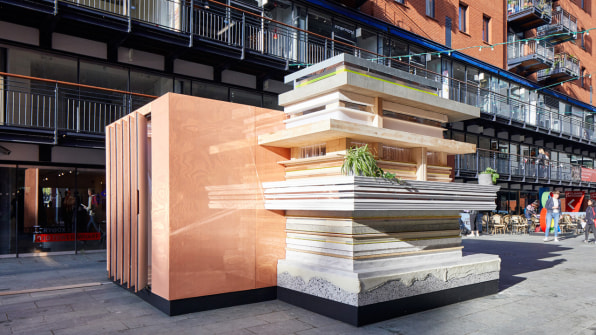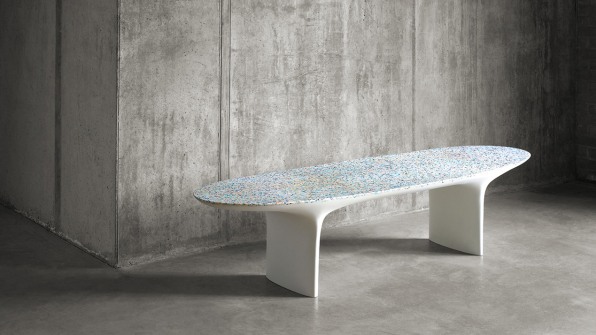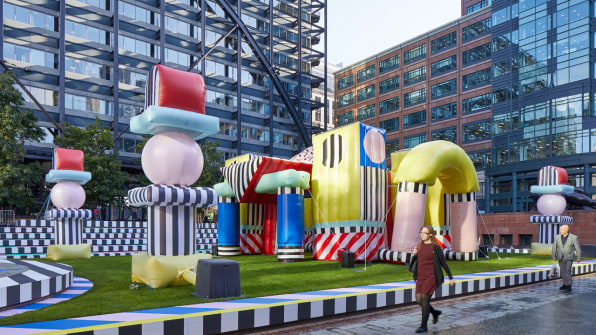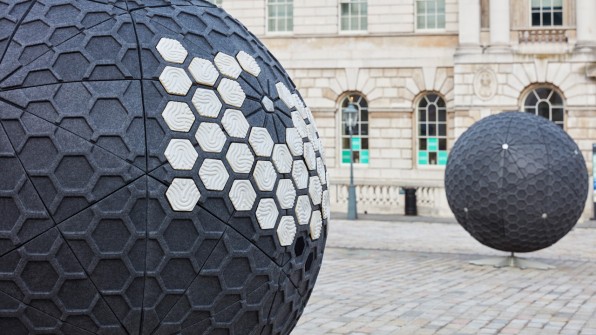Creative Warehouse Living London
The London Design Festival is one of the world's seminal annual design events, with hundreds of designers displaying their work and creating custom installations for the festival. It's also a barometer of where design is headed–and how it'll shape our lives in the future.
We've combed through the offerings from this year's festival to find the most intriguing, thought-provoking projects and concepts. Sustainability was a common theme, with everything from a mobile recycling plant to tables made of ocean plastic. Other designers focused on the housing, transportation, and cities of tomorrow. And some designers–see Camille Walala's Memphis-inspired inflatable playground–just wanted to have a little fun.

The Cramped (But Beautiful) Apartments Of The Future
Mini has been expanding outside its roots as a car company through an initiative called Mini Living, where the company presents concepts and prototypes envisioning the future of cities. Its latest idea, the Urban Cabin, premiered at LDF outside the Oxo Tower in Southbank. Designed by Sam Jacob Studio, the Urban Cabin has a shared kitchen with a counter that extends to the outside of the house, a tiny library filled with books about London, and a hammock for lounging–all within about 160 square feet. As housing gets more and more expensive in world cities like London, this type of dwelling shows what affordable living spaces might look like one day.

Furniture Made Of Recycled Ocean Plastic
Don't let the beautiful forms of this series of furniture deceive you–they're actually made out of recycled ocean plastic. Designed by London-based Brodie Neill, the pieces are made of a material he invented called "ocean terrazzo" in which Neill sanitizes and dyes plastic that's washed up on the beach and then sets it into resin. For LDF, a new series of pieces called Flotsam were on display at the ME London hotel, including a bench and a coffee table. The coffee table has an indented surface, and as part of an installation for the hotel, Neill filled it with water. Every minute, a single drop falls from the ceiling into the small pond, keeping the surface of the table constantly rippling. The movement of the water is tracked, magnified, and then projected onto the walls, making it look like a wave has washed across the room. The use of ocean terrazzo in a high-end setting points to a future where luxury design issustainable design.

The Bold Memphis-Inspired Vision Of Villa Walala
Amid a series of glassy skyscrapers, the graphic and textile designer Camille Walala erected a brightly colored and strikingly patterned inflatable structure. Citing the Memphis Group's blocky mix of color and pattern as her primary influence, Walala has transformed a staid public space into a whimsical playground passersby can explore. She first wanted to make a giant stress ball to help office workers decompress, but eventually settled on an inflatable promenade that has the ethos (if not the interactivity), of a children's bouncy house. Who says cities of the future can't be fun?

Tiles Made From A Mobile Recycling Plant
As part of the Design Frontiers exhibition at Somerset House, the upcycling furniture company Pentatonic created "ceramic" tiles out of London's trash. To do so, the company used the Trashpresso, a mobile recycling plant created by the Taiwan-based sustainability company Miniwiz, which launched earlier this year. You can bring your own trash to Somerset House's courtyard, where it is shredded into tiny pieces, washed, placed into molds and then baked–using only the power of the sun to fuel the process. Pentatonic invents new types of materials using trash, and primarily sells chairs and tables made out of these recycled materials–which one day might infiltrate our homes.
Hyperloop Designers, Hard At Work
How does a design concept come to life? At LDF, the prestigious transportation design firm PriestmanGoode put on an installation called "Please Don't Feed the Designers" where they gave visitors a look at their team working together on a concept for hyperloop–super-fast transit through vacuum tubes. The firm released initial concepts for hyperloop pods for the company Hyperloop Transportation Technologies, and continued to work on the idea throughout the festival. The renderings show a futuristic vehicle sliding through a clear tube, shaped almost like a rocket or a bullet train. The idea includes virtual windows for passengers (so they forget that they are shooting through a tube at high speeds), as well as more train-like elements: entry areas, food kiosks, and toilets. The idea proposes a future not only of superfast travel, but also an attention to human needs–who wants to spend hours inside a windowless tube?
A Pop Up Space For Creativity–No Laptops Or Phones Allowed
CalledOn Repeat, the space was built by London-based Universal Design Studio and a firm that focuses on flexible workspace called The Office Group for the festival. Made of wooden slats and outfitted with a long table and chairs, the space is sandwiched between two buildings in London's tech district Shoreditch. People are forbidden from using laptops and cell phones in it. Instead, visitors can make paper lanterns and hang them from the ceiling. The repetitive nature of the timber slats and the rows of lanterns are supposed to help designers find peace and mindfulness. In the city of the future, these tech-free spaces might become more prominent, giving our minds and souls a break from a highly interactive world.
Creative Warehouse Living London
Source: https://www.fastcompany.com/90143904/the-london-design-festival-looks-toward-the-future-of-living








Tidak ada komentar:
Posting Komentar